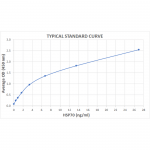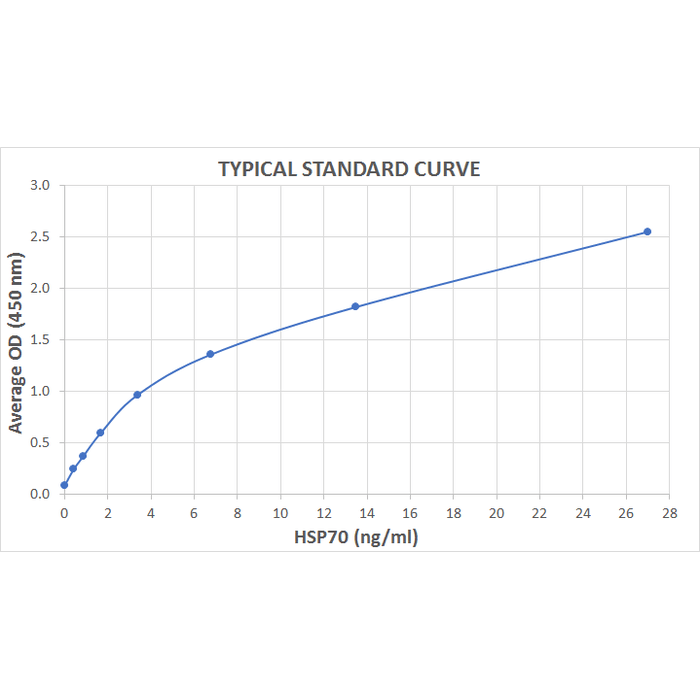| Product Name | HSP70 ELISA Kit (High-Sensitivity) |
| Description |
High-Sensitivity Colorimetric detection of HSP70 |
| Species Reactivity | Dog, Human, Monkey, Mouse, Rat |
| Platform | Microplate |
| Sample Types | Cell lysates, Plasma, Serum, Tissue |
| Detection Method | Colorimetric Assay |
| Assay Type | Sandwich ELISA (Enzyme-linked Immunosorbent Assay) |
| Utility | ELISA kit used to quantitate HSP70 concentration in samples. |
| Sensitivity | 0.038 ng/ml |
| Assay Range | 0.42 - 27 ng/ml |
| Incubation Time | 30 minutes |
| Number of Samples | 40 samples in duplicate |
| Other Resources | Kit Booklet Lot No. VH853927 , Kit Booklet Lot No. VH477277 , Kit Booklet Lot No. VH777390 , Kit Booklet Lot No. VH288828 , MSDS |
| Field of Use | Not for use in humans. Not for use in diagnostics or therapeutics. For in vitro research use only. |
Properties
| Storage Temperature | 4ºC and -20ºC | |||||||||||||||||||||||||||||||||
| Shipping Temperature | Blue Ice | |||||||||||||||||||||||||||||||||
| Product Type | ELISA Kits | |||||||||||||||||||||||||||||||||
| Assay Overview | 1. Prepare Standard and samples in Standard and Sample Diluent. 2. Add 100 µL of Standard or sample to appropriate wells. 3. Cover plate with Plate Sealer and incubate at 37°C for 1 hour with shaking at 600rpm. 4. Wash plate four times with 1X Wash Buffer. 5. Add 100 µL of Biotinylated Antibody Working Solution to each well. 6. Cover plate with Plate Sealer and incubate at at 37°C for 1 hour with shaking at 600rpm. 7. Wash plate four times with 1X Wash Buffer. 8. Add 100 µL of Streptavidin-HRP Working Solution to each well. 9. Cover plate with Plate Sealer and incubate at 37°C for 30 minutes with shaking at 600rpm. 10. Wash plate four times with 1X Wash Buffer. 11. Add 100 µL of TMB Substrate to each well. 12. Develop the plate in the dark at room temperature for 30 minutes. 13. Stop reaction by adding 100 µL of Stop Solution to each well. 14. Measure absorbance on a plate reader at 450 nm. | |||||||||||||||||||||||||||||||||
| Kit Overview |
|
|||||||||||||||||||||||||||||||||
| Cite This Product | HSP70 ELISA Kit (High-Sensitivity) (StressMarq Biosciences Inc., Victoria BC CANADA, Catalog # SKT-108) |
Biological Description
| Alternative Names | HSP70 1, HSP70 2, HSP70.1, HSP72, HSPA1, HSPA1A, HSPA1B |
| Research Areas | Cancer, Cell Signaling, Chaperone Proteins, Heat Shock, Protein Trafficking, Tumor Biomarkers |
| Scientific Background |
Heat Shock Protein 70 (HSP70) is a highly conserved molecular chaperone encoded by a multigene family and expressed across all major cellular compartments, including the cytosol, mitochondria, and endoplasmic reticulum. HSP70 binds to nascent and misfolded proteins, preventing aggregation and facilitating proper folding through ATP-dependent conformational changes. In neuroscience, HSP70 plays a critical role in maintaining proteostasis under stress conditions. Its ability to stabilize unfolded proteins is especially relevant in neurodegenerative diseases such as Alzheimer’s, Parkinson’s, and ALS, where protein misfolding and aggregation are central to pathogenesis. HSP70’s dynamic binding and release cycles are essential for neuronal survival, synaptic function, and cellular resilience. By modulating HSP70 activity, researchers aim to enhance the brain’s natural defense mechanisms against proteotoxic stress, making it a promising therapeutic target in neurodegeneration. |
| References |
1. Zho J. (1998) Cell. 94: 471-480. 2. Boorstein W. R., Ziegelhoffer T. & Craig E. A. (1993) J. Mol. Evol. 38 (1) 1-17. 3. Rothman J. (1989) Cell 59: 591 -601. 4. DeLuca-Flaherty et al. (1990) Cell. 62: 875-887. 5. Bork P., Sander C. & Valencia A. (1992) Proc. Natl Acad. Sci. USA. 89: 7290-7294. 6. Fink A.L. (1999) Physiol. Rev. 79: 425-449. 7. Smith D.F., et al. (1993) Mol. Cell. Biol. 13(2): 869-876. 8. Prapapanich V., et al. (1996) Mol. Cell. Biol. 16(11): 6200-6207. 9. Fernandez-Funez et al. (2000) Nature. 408(6808): 101-106. |



StressMarq Biosciences :
Based on validation through cited publications.